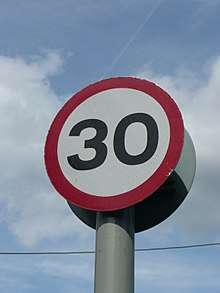Built-up area (Highway Code)
In the UK Highway Code, a built-up area is a settled area in which the speed limit of a road is automatically 30 mph (48 km/h). These roads are known as 'restricted roads' and are identified by the presence of street lights.

History
In 1930, the concept of specific regulation for roads within built-up areas appears. It defines the road as a road within built-up area if some system of street lighting exists at less than 200 yards (183 meters) from that road, unless decided other way by the local authority and written on traffic signs.[1]
In 1984, appears the Road Traffic Regulation Act 1984, which is the basis of the current law.
In 2018, mainland UK becomes a member of the Vienna convention on road traffic which consider that the concept of built-up area should be defined by the domestic legislation.
Legal definition
In August 2006, the Department for Transport issued new guidance relating to speed limits. It states that:[2]
Section 82(1)(a) (of the Road Traffic Regulation Act 1984 (RTRA 1984)) defines a restricted road in England and Wales as a road which is provided with "a system of street lighting furnished by means of lamps placed not more than 200 yards apart". Section 81 specifically makes it an offence for a person to drive a motor vehicle at a speed of more than 30 mph on a restricted road.
"Street lighting" is further defined as follows:
As set out in paragraph 45, it is generally recognised that a 'system' of street lighting could be three or more lamps spaced not more than 183 metres apart. However, street lighting (for the purposes of determining whether or not a road is a restricted) is not necessarily limited to street lamps, but may extend to lighting provided by authorities or parish councils.
To avoid confusion that could arise if some 30 mph zones were 'street-lit' and some were not, DfT guidance goes onto say:
Direction 11 of The Traffic Signs Regulations and General Directions 2002 (TSRGD 2002) defines the requirements for the placing of speed-limit repeater signs. This states that speed-limit repeater signs cannot be placed along a road on which there is carriageway lighting not more than 183 metres apart and which is subject to a 30 mph speed limit. The Department will not make exceptions to this rule.
This has led to the conclusion that:
This means it should be assumed that, unless an order has been made and the road is signed to the contrary, a 30 mph speed limit applies where there are three or more lamps throwing light on the carriageway and placed not more than 183 metres apart.
However, Government guidance defines "street" and therefore "street lighting" in the following Department of Transport document: Manual for Streets (2007), and applies formally in England and Wales ( Gillian Merron MP Transport Minister; Baroness Andrews OBE Parliamentary Under Secretary of State Communities and Local Government; Tamsin Dunwoody AM Deputy Minister for Enterprise, Innovation and Networks Deputy Minister for Environment, Planning & Countryside):
1.1.7 For the purposes of this document, a street is defined as a highway that has important public realm functions beyond the movement of traffic. Most critically, streets should have a sense of place, which is mainly realised through local distinctiveness and sensitivity in design. They also provide direct access to the buildings and the spaces that line them. Most highways in built-up areas can therefore be considered as streets.
According to Department for Transport's Manual for Streets,[3] by definition, a "street" provides direct access to buildings and spaces that line them, in built-up areas. All roads and carriageways are not all "streets".
"Road lighting", as distinct from "street lighting", encompasses the lighting of all types of highway, public maintainable streets and roads. "Street lighting" is term-specific to "streets" – that is: to highways allowing direct access to buildings or spaces in built-up areas.
Therefore, the conclusion drawn above, should be considered specific to "streets", lit with "street lighting". Roads that cannot clearly be defined as "streets" should not be presumed to have a speed limit of 30 m.p.h., where no speed limit sign is in place.
British Standards on "Road Lighting" are contained in the following documents: BS EN13201-1-2004; BS 5489:1:2003[4]
Legislation
Most road traffic law pertaining to speed limits is contained in the Road Traffic Regulation Act 1984 (RTRA 1984). Other relevant legislation includes the Highways Act 1980, where Sections 90A-F cover road humps and Sections 90G-I cover other traffic-calming works. Part VI of the RTRA 1984 deals specifically with speed limits, with Sections 81–84 dealing with different speed limits and the speed-limit order-making process.
Highway Code in Northern Ireland
In Northern Ireland, the Highway Code of Northern Ireland has only three references to the "built-up area" and does not define it.
In Northern Ireland, the Highway Code forbids the use of the horn within built-up area between 11h30 and 19h, except in case of danger,[5] consistently with article28 of the Vienna convention.[6]
In Northern Ireland, the Highway Code forbids speeds higher than 30 mph in built-up areas.[7]
See also
- Built-up area
- Speed limit
References
- http://www.legislation.gov.uk/ukpga/1934/50/pdfs/ukpga_19340050_en.pdf
- Department for Transport (8 August 2006). "DfT Circular 01/2006: Setting Local Speed Limits". Archived from the original on 6 February 2007. Cite journal requires
|journal=(help) - https://www.gov.uk/government/uploads/system/uploads/attachment_data/file/341513/pdfmanforstreets.pdf
- "UK Road Lighting". www.ukroads.org.
- https://www.nidirect.gov.uk/sites/default/files/publications/The-official-Highway-Code-for-Northern-Ireland.pdf number 112
- https://assets.publishing.service.gov.uk/government/uploads/system/uploads/attachment_data/file/679994/MS1.2018_CM9570__Convention_on_Road_Traffic_WEB.pdf
- https://www.nidirect.gov.uk/sites/default/files/publications/The-official-Highway-Code-for-Northern-Ireland.pdf page 40